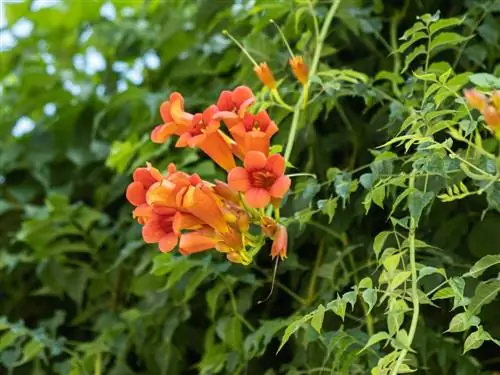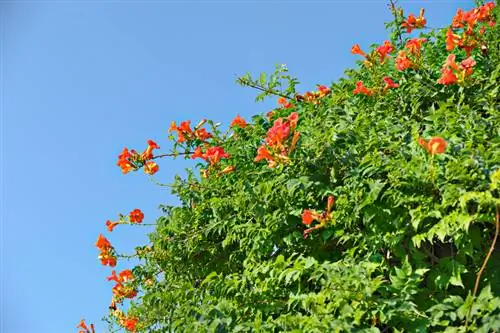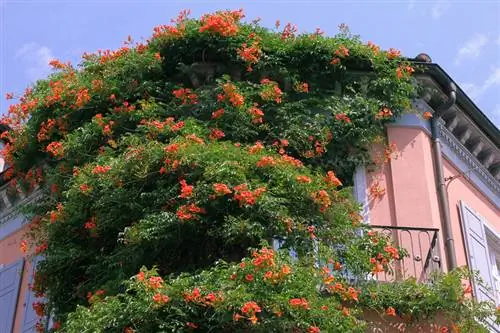- Author admin [email protected].
- Public 2023-12-16 16:46.
- Last modified 2025-06-01 06:02.
Read the commented profile of the climbing trumpet here for compact information about growth, winter hardiness and flower splendor. You can find out how to properly plant, care for and cut the trumpet flower here.

What is the climbing trumpet?
The climbing trumpet (Campsis radicans) is an attractive, fast-growing climbing plant with trumpet-shaped flowers and pinnate leaves. It is hardy, poisonous and is suitable for greening pergolas, house walls or climbing aids. The flowering period is from June to October.
Profile
- Scientific name: Campsis radicans
- Family: Trumpet tree family (Bignoniaceae)
- Synonyms: trumpet flower, trumpet morning glory, jasmine trumpet
- Origin: America
- Growth type: climbing plant
- Growth height: 6 m to 10 m
- Flower: trumpet-shaped
- Leaf: pinnate
- Roots: Shallow roots, forms adhesive roots
- Toxicity: poisonous
- Winter hardiness: hardy
- Use: Greening of pergola, house wall, climbing aid
Growth
The climbing trumpet is a strong-growing, flower-rich liana from the southern regions of North America. In the riparian forests of Florida and along the Mississippi, the climbing plants are rooted in the ground, reach up to the sky with twining shoots and make the trees shine with their orange flowers. As early as the 17th century, the exotic flower beauty was imported to Europe for the representative garden design of the nobility. To this day, the American trumpet flower delights creative hobby gardeners as a spectacular climbing plant with this growth:
- Growth type: woody, deciduous climbing plant with exuberant flowers and decorative pinnate leaves.
- Growth height: 6 m to 10 m
- Growth width: 3 m to 6 m
- Bark: on a young plant grey-olive to green, later ocher yellow to light gray and distinctively furrowed.
- Growth speed: 80 cm to 150 cm growth per year.
- Roots: flat roots with runners in the ground, adherent roots on the shoots.
- Important horticultural properties: perennial, easy to care for, tolerates cutting, above-ground plant parts slightly toxic.
If there is no climbing aid within reach of the shoots with adhesive roots, the climbing plant becomes a flowering ground cover.
Bloom
The climbing trumpet's floral fireworks ignite as a sea of ornamental individual flowers with these properties:
- Inflorescence: terminal clusters or panicles with several individual flowers.
- Flower shape: funnel or trumpet-shaped, 5 cm to 8 cm long.
- Flower colors: orange to yellow or bright orange-red to brick red.
- Flowering time: June to October.
- flower ecology: hermaphrodite
- Pollinators: Bees and bumblebees.
Pollinated flowers turn into decorative, pod-shaped capsule fruits with winged seeds. Like all other parts of the plant, the pods are poisonous and not suitable for consumption.
Video: Trumpet flower in full bloom
Leaf
Pinnate leaves perfect the ornamental value of a trumpet flower. You can easily recognize the reed of a climbing trumpet by these features:
- Leaf shape: petiolate, imparipinnate with 7 to 11 leaflets, leaf edge sawn or toothed.
- Leaf size: 15 cm to 25 cm long.
- Leaf color: Young plant light green, later strong medium green with a bright, golden yellow autumn color.
- Arrangement: opposite
Winter hardiness
Thanks to its North American origins, the climbing trumpet is equipped with a robust winter hardiness of up to -20° Celsius. Experienced hobby gardeners know that this value should be treated with caution. As a young plant or potted plant, the trumpet flower is vulnerable to frost and requires winter protection.
Usage
One look at the breathtaking blossoms sparks creative design ideas. Get inspired by these options for imaginative uses:
- Pergolas provide shade and vegetation.
- Make facades, walls, wooden and metal fences rich in flowers.
- Plant between evergreen conifer hedges for bright color accents.
- Let it climb up old trees as a natural climbing aid.
- Combine with Clematis 'Rubens' or other early-flowering clematis for an extra long flowering period.
Due to the poisonous parts of the plant, the climbing trumpet is not suitable for the family garden. As a non-toxic alternative, climbing roses with summer blooms green pergolas, facades and other climbing aids in sunny locations.
Excursus
Chinese climbing trumpet - little sister of Campsis from Asia
The Chinese climbing trumpet (Campsis grandiflora) fulfills the wish for a more compact trumpet flower. With a growth height of 200 cm to 400 cm, the little sister of the American climbing trumpet (Campsis radicans) is recommended as a flower-rich privacy screen in a pot on the terrace. The Asian, hardy climbing plant quickly climbs any stable climbing aid with its adhesive roots. From July to October, orange trumpet flowers accompany the feathery leaves. Also interesting is the Great Climbing Trumpet (Campsis tagliabuana) as a successful cross between Campsis radicans and Campsis grandiflora.
Planting a climbing trumpet
The best time to plant climbing trumpets is in the spring after the Ice Saints. This is important so that a young plant is well rooted until the first frost. The following planting tips will inform you about the location and planting technique for a trumpet flower, whose first bloom will not be long in coming.
Location
With the flower head in the sun and a shaded root area, the climbing trumpet develops its optimum. These site conditions meet the requirement:
- Full sun, warm, wind-protected location with shadows cast on the root disk.
- Normal garden soil, preferably fresh and moist, rich in nutrients, humus, permeable and calcareous.
- Exclusion criteria: waterlogging, acidic pH value less than 4, 5.
With underplanting that is compatible with root pressure, you can create beneficial shadows on the root area. Suitable plants are mountain mint (Calamintha nepeta), lady's mantle (Alchemilla erythropoda), golden hair aster (Aster linosyris) or Japanese mountain grass (Hakonechloa macra).
Plants in the bed
The following short instructions explain how to properly plant a climbing trumpet and stop its urge to spread:
- Place the root ball in water until no more air bubbles appear.
- Meanwhile, weed the soil, loosen it, incorporate coarse sand and compost soil.
- Dig a planting pit with twice the diameter of the root ball.
- Line the pit with a rhizome barrier.
- Unpot the climbing trumpet, plant it and water it.
With its adhesive roots, the climbing trumpet is self-climbing. Nevertheless, trumpet flowers are grateful for a simple climbing aid in the form of wires, ropes or wooden sticks. The looping tendrils find a better grip on the scaffolding, especially on smooth surfaces and at heights of 2 meters or more.
Plants in pots
The climbing trumpet is planted in a large bucket or box with a volume of 30 to 40 liters and openings in the bottom for water drainage. Ideally, the climbing aid is integrated into the vessel, for example as a trellis, pyramid or rattan weave. This way the potted plant is mobile and easy to overwinter. The substrate used is commercially available potted plant soil without peat, enriched with coconut fibers and expanded clay for optimal structural stability. Drainage made of pottery shards or fine-grained gravel drains away excess irrigation water and prevents waterlogging.
Care for the climbing trumpet
The climbing trumpet is easy to care for, provided that it receives regular gardening attention. Watering when it is dry and a portion of compost in spring cover the water and nutrient supply. In addition to this basic care, the picturesque climbing plants benefit from annual pruning and simple winter protection.
Cutting
Climbing trumpets bloom on this year's shoots and are easy to cut. Pruning regulates strong growth and promotes flowering. How to cut a trumpet flower correctly:
- The best time is between the end of February and mid-March.
- Gloves and long-sleeved clothing protect against the toxic plant sap.
- Throughly thin out the trumpet bush, cut out unfavorable, diseased tendrils.
- Cut back last year's flower shoots by half or down to 2 pairs of buds..
- Short remaining side shoots as desired for strong branching with new flower shoots.
Following pruning is a good opportunity for the recommended starter fertilization with compost.
Wintering
Cold wind and constant winter wetness shake the certified winter hardiness of a climbing trumpet. When cultivated in a bucket, frost tolerance decreases significantly. The only people who are on the safe side are hobby gardeners in regions with mild winters, such as wine-growing regions or on the Lower Rhine. Winter protection is definitely recommended elsewhere:
- In the bed: cover the root area with leaves and brushwood, clamp spruce branches between the shoots.
- In the pot outside: Cover the container thickly with fleece, place it on wood, mulch the root disk with straw, place a reed mat in front of the climbing aid or put a breathable, translucent hood over it.
- Inside the pot: Move the potted plant to a bright, frost-free winter quarters before the first frost
Diseases, pests, care problems
The climbing trumpet rarely gives rise to complaints about diseases and pests. If the exotic climbing artist is weak, she usually suffers from care errors. The following table points out common malfunctions, lists the causes and gives tips for solving the problem:
| malicious image | Cause | What to do? |
|---|---|---|
| Leaf spots, sticky coating, curled edges | Aphids | fight with curd soap and spirit solution |
| Dirty-floury topping | Mildew | cut off affected plant parts, spray milk-water solution |
| Fewer flowers every year | Aging | Pruning to 2 pairs of leaves |
| Brown leaves, flowers dropping | Drought stress | water thoroughly, shade the root area |
Popular varieties
A collection of top-class Campsis varieties delights with glamorous flower performance in the bed, on the south-facing balcony and on the sun-drenched terrace:
- Madame Galen: popular large climbing trumpet (Campsis tagliabuana) with orange-red flowers, growth height up to 500 cm.
- Flava: yellow trumpet flower with golden yellow flowers from July to September, climbs 200 cm to 400 cm high.
- Stromboli: Premium variety from France impresses with bright red trumpet flowers up to 8 cm long.
- Indian Summer: American climbing trumpet with furious, yellow-orange-red flowers until October, growth height up to 600 cm.
FAQ
Is the climbing trumpet hardy?
The original species Campsis radicans is hardy down to -20° Celsius. Varieties resulting from this suffer frost damage at temperatures as low as -10° Celsius, so winter protection makes sense. Cultivated in pots, the exotic climbing plants are significantly more sensitive to frost and benefit from overwintering under glass.
How should climbing trumpets be propagated?
Climbing trumpets and their varieties are easiest to propagate using planters. Place a promising annual vine on the ground in a 10 cm deep furrow in spring. By next year, the offshoot will form its own root system. In spring, separate the mother plant and young plant with a smooth cut. The new climbing trumpet can either be cultivated as a pot plant or planted in the bed at the new location.
Do trumpet flowers form adhesive roots on masonry, similar to ivy?
In fact, a trumpet flower climbs the house wall with the help of adhesive roots. However, climbing height is limited on this relatively smooth surface. To ensure that the overhanging tendrils do not fall due to their own weight, we recommend installing a stable climbing aid from a height of around 2 m.
Is Campsis radicans poisonous?
All parts of a Campsis radicans plant are poisonous. The highest concentration of toxic ingredients is in the seeds of the pod-shaped fruits. Intentional or unintentional consumption causes nausea and vomiting. Skin contact with the plant sap can cause annoying itching. However, the climbing trumpet is not nearly as dangerous as the deadly and poisonous angel's trumpet (Brugmansia).






